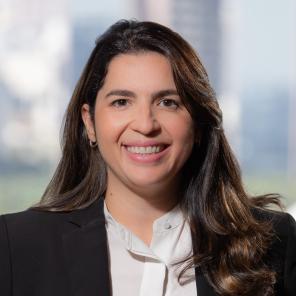
Mariana Reis-Havlat is a clinician-scientist by training and holds a position as visiting research assistant professor at the University of Illinois at Chicago, department of Oral Biology. She received her DDS (2014) and PhD (2017) degrees from the University of Sao Paulo, Brazil. Currently, she is the principal investigator of a NIDCR Dentist Scientist Pathway to Independence Award (K99/R00). Between 2018-2022, as a post-doctoral research fellow at the University of Illinois at Chicago and Marquette University, she pursued additional research training in applied dental biomaterials and tooth biology. She advanced her knowledge in the chemistry and mechanics of the dentin extracellular matrix as part of a well-established multidisciplinary research team. Concurrently, she worked on projects to elucidate the impact of aging on the chemical-mechanical characteristics of dental mineralized tissues. These efforts resulted in published abstracts, over 15 peer-reviewed publications, and the participation in international and national events and awards. She has been a member of the IADR/AADOCR since 2016 and also a member of the IADR/AADOCR Dental Materials, Mineralized Tissues, and Women in Science groups.
Please briefly describe your background and research interests.
While in dental school, I worked full time as an English teacher and pedagogical coordinator and fell in love with education. Around 2011, I decided to unite my passion for education with my dental studies and follow a career in academia. After I obtained my DDS in 2014, I continued my path within biomaterials and oral biology research by pursuing my doctoral studies to further enhance my research skills and training in academia. I acquired many unique perspectives and gained countless insights from my mentors, my post-graduate peers and from each research project I worked on. I engaged in training from three major research institutions, the University of Sao Paulo, Paulista State University, and the University of Oklahoma. I learned how to plan experimental assays, operate state-of-the-art equipment, mentor pre-doctoral dental students and assess lectures to instruct dental students and research volunteers in pre-clinical courses. My training focused on surface characterization of dental biomaterials and their association with thin films, and interaction with oral biofilms. To further advance my research training and career development, I engaged in a post-doctoral research fellowship. This was an amazing and unique experience, personally and professionally, in which I lived in different cities (Chicago and Milwaukee), worked at great institutions while being part of diverse collaborative research led by an outstanding principal investigator and mentor. I used my previous expertise in surface characterization and applied it to dental tissues. I advanced my knowledge in the chemistry and biomechanics of dentin and conducted research projects to analyze the biochemistry and viscoelastic properties of modified dentin after the use of natural plant-based biomimetic agents. Furthermore, I obtained understanding of the ultrastructure and mechanical features of dentin associated with age. The experience gained from my post-doctoral studies combined with my previous education and training propelled me to pursue the next steps of my career and initiate a transition to become an independent clinician-scientist. I submitted a NIDCR K99/R00 proposal with the objective to investigate the structure and biology of cementum and the complexities of the effects of aging and periodontal disease to tissue fundamental periodontal tissue. I was selected for this noteworthy award in 2022. My overall research goal is to investigate the state of cementum with age and disease and to elucidate age-related molecular mechanisms that could contribute to the development of individualized therapeutic strategies for the aging population.
How did you first learn about the AADOCR Mind the Future Program, and what motivated you to apply?
I learned about the AADOCR Mind the Future Program from fellow peers of previous MIND the Future cohorts and my mentor, who also served as a MIND the Future Program Mentor. Everything about the program interested me, particularly the educational-mentoring activities and the possibility to build a wider network within the scientific and academic communities that includes a diverse group. Additionally, the opportunity to work on research and grant writing with the advisory and management committee alongside collaboratively working with an assigned mentor strongly contributed for my application to the program. As an early career dentist-scientist in transition to an independent research faculty position, participating in a successful program that can provide additional support across a multitude of aspects of career development and research is outstanding.
What has been the most valuable benefit of AADOCR membership to you?
I believe that the most valuable benefit of being an AADOCR member is the interpersonal relationships you establish with other members. As part of the AADOCR, you can connect with people within diverse settings, as in-person in the annual meetings, virtually, through the scientific groups and networks etc. These connections are founded in the common interest of advancing dental, oral, and craniofacial research and building a solid educational and scientific network. It has been a pleasure and honor to be a member and to continuously grow with the AADOCR community.
What is the best way for other members to become more involved in AADOCR and get the most out of the membership?
I believe that the first thing that can help other members to be more involved in the AADOCR is to get associated to scientific groups and networks that are part of your interest and that can potentially foster future collaborations and connections. Participating in the in-person meetings, interacting with other scientists and educators at lectures and poster sessions, signing up for events, newsletters and of course volunteering! There are diverse opportunities to engage in each aspect of the AADOCR that can definitely expand your professional network and foster future collaborators and projects.




